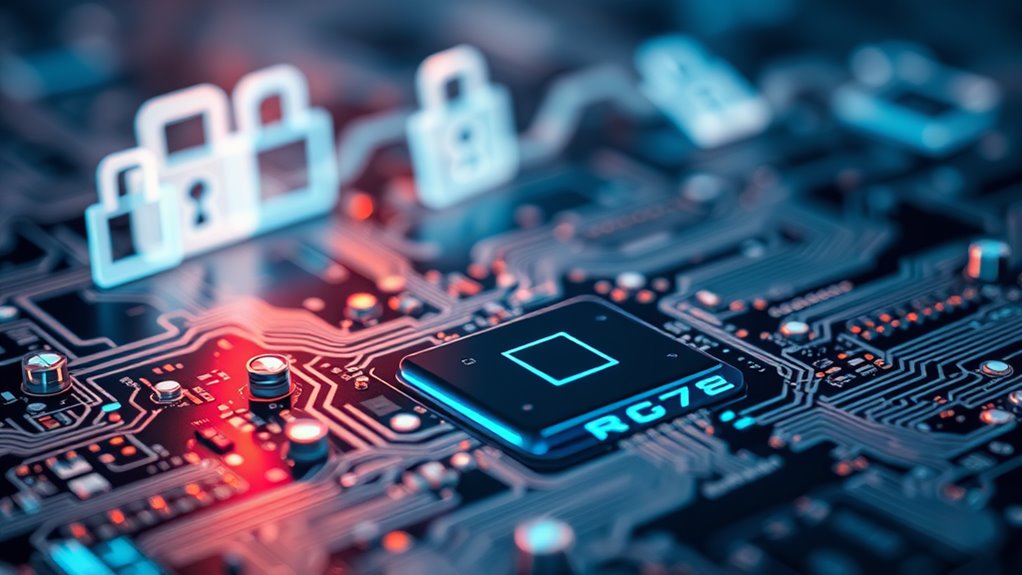
Future of Crypto Security: Emerging Trends and Defenses
Cryptocurrency security is evolving through several key innovations. AI systems now detect threats in real-time while blockchain provides tamper-proof transaction records. The industry faces challenges from quantum computing, which threatens current cryptographic methods. Post-quantum algorithms and advanced hardware solutions like biometric authentication offer promising defenses. Meanwhile, regulatory frameworks are developing globally to establish consistent security standards. Cross-chain protocols and Layer 2 solutions address vulnerabilities in blockchain interactions. These emerging technologies represent the foundation of tomorrow’s digital asset protection.
Key Takeaways
- AI integration enables real-time threat detection through pattern analysis, providing proactive protection against sophisticated cyberattacks.
- Post-quantum cryptography adoption is crucial as quantum computing threatens current encryption methods used in blockchain systems.
- Cross-chain security protocols and bridge protection mechanisms help prevent attacks on vulnerable points between different blockchain networks.
- Multi-factor authentication combining hardware wallets, biometrics, and security keys creates layered defense against unauthorized access.
- Zero-knowledge proofs and privacy-enhancing technologies allow transaction verification without compromising sensitive data.
The Convergence of AI and Blockchain Security

As cybersecurity threats become increasingly sophisticated, the integration of artificial intelligence and blockchain technology represents one of the most promising developments in digital security.
This powerful combination leverages blockchain’s immutable, decentralized architecture alongside AI’s analytical capabilities to create more robust protection systems.
AI enhances blockchain security by analyzing transaction patterns to detect anomalies and potential threats in real-time, while blockchain provides tamper-proof logs that guarantee data integrity.
AI’s analytical power plus blockchain’s immutable ledgers create unparalleled security through real-time threat detection and guaranteed data integrity.
Together, they enable automated incident response and smart security audits that identify vulnerabilities traditional methods might miss. Moreover, implementing multi-factor authentication significantly strengthens user verification and reduces the risk of unauthorized access.
In applications ranging from financial services to supply chain management, this convergence offers decentralized security solutions that adapt to evolving threats, though implementation challenges remain due to technical complexity and the need for specialized expertise.
Quantum Computing Threats and Post-Quantum Cryptography

While cryptocurrency enthusiasts celebrate blockchain’s security features, a looming technological revolution threatens to undermine the very foundations of this security.
Quantum computing, which leverages qubits capable of representing multiple states simultaneously, poses significant challenges to current cryptographic systems that protect digital assets.
- Bitcoin’s ECDSA and Schnorr signatures lack quantum resistance, creating vulnerabilities to future quantum attacks
- NIST has selected several post-quantum cryptographic schemes that will become new security standards
- The “harvest now, decrypt later” strategy allows adversaries to store encrypted data for future quantum decryption
- Implementing quantum-resistant solutions like Lamport signatures requires substantial coordination across platforms
Though this threat isn’t imminent—practical quantum computers capable of breaking current cryptography remain years away—the cryptocurrency industry must prepare by evolving to quantum-resistant algorithms to protect long-term security.
Advanced Decentralized Security Protocols

Beyond the potential threats of quantum computing, the cryptocurrency ecosystem has developed sophisticated decentralized security protocols that form the backbone of blockchain protection. These protocols employ cryptographic techniques including digital signatures and hash functions to verify transactions while maintaining data integrity across distributed networks.
| Protocol Type | Key Benefit | Implementation Example |
|---|---|---|
| Consensus Mechanisms | Distributed validation | Proof of Work, Proof of Stake |
| Zero-Knowledge Proofs | Privacy preservation | ZK-SNARKs in privacy coins |
| Cross-Chain Security | Interoperability | Atomic swaps, wrapped tokens |
Smart contract security has evolved through formal verification and automated auditing tools that identify vulnerabilities before deployment. These advancements, coupled with AI-powered anomaly detection, create robust defense systems that minimize centralized points of failure while maximizing network resilience against sophisticated cyber threats. Additionally, rigorous testing is essential for ensuring that smart contracts remain secure and reliable throughout their lifecycle.
Regulatory Frameworks Shaping Crypto Protection Standards

As regulatory bodies worldwide work toward establishing common crypto security standards, companies face competing pressures between self-regulation and increasing governmental oversight.
The Financial Stability Board’s efforts to harmonize global frameworks under the “same activity, same risk, same regulation” principle highlights the growing consensus on the need for consistent protection measures.
Despite these standardization efforts, enforcement challenges persist across borders, with countries like the United States and European Union taking markedly different approaches to crypto regulation and consumer safeguards.
Global Compliance Standardization
The emergence of regulatory frameworks for cryptocurrencies represents a critical evolution in the digital asset landscape. As jurisdictions worldwide develop standards, the EU’s MiCA framework has emerged as a leading model, establishing consistent requirements across member states.
The Financial Stability Board coordinates these efforts globally, working to harmonize approaches and reduce regulatory arbitrage risks.
Key developments in global compliance include:
- Stringent stablecoin regulations requiring 1:1 liquidity reserves for fiat-backed coins
- International organizations like FATF and IOSCO establishing unified standards for investor protection
- Regional differences creating implementation challenges despite coordination efforts
- Central Bank Digital Currencies (CBDCs) influencing the regulatory landscape for private cryptocurrencies
This standardization aims to balance innovation with security, though many jurisdictions still maintain fragmented regulatory approaches. Additionally, as countries adopt innovation-friendly regulations, the potential for increased investment in the crypto sector may further enhance security measures.
Self-Regulation vs. Oversight
While global compliance standards establish a regulatory foundation, the cryptocurrency industry continues to explore the balance between self-governance and government oversight.
Self-regulatory organizations (SROs) offer potential benefits, including industry expertise, regulatory efficiency, and adaptability to rapid technological changes. These non-governmental entities can help set standards and enforce rules while fostering innovation and reducing burdens on government agencies.
However, challenges remain significant. Critics point to risks of industry capture by powerful players and inherent conflicts of interest. Additionally, the decentralized nature of cryptocurrencies complicates traditional regulatory approaches, particularly in areas like anti-money laundering enforcement. As the market matures, the rise of institutional adoption will likely further influence the development of effective regulatory frameworks.
The crypto sector must navigate this tension, potentially developing hybrid models that combine industry self-regulation with appropriate governmental oversight to protect consumers while supporting continued technological development.
Cross-Border Enforcement Challenges
Maneuvering the complex landscape of international cryptocurrency regulation presents unprecedented challenges for enforcement agencies worldwide. The decentralized nature of blockchain technology creates significant jurisdictional ambiguities, as transactions occur across multiple territories simultaneously without respect for national borders.
- Regulatory Inconsistency: Different classifications of cryptocurrencies (as securities, commodities, or currencies) across jurisdictions create enforcement gaps.
- Jurisdictional Determination: Identifying which laws apply becomes problematic when transactions involve nodes in multiple countries.
- Limited Cooperation Frameworks: Despite FATF guidelines, many regions lack established protocols for information sharing in crypto-related investigations.
- Technical Barriers: Privacy-enhancing cryptocurrencies and mixing services complicate transaction tracing efforts.
These challenges necessitate stronger international cooperation and harmonized regulatory frameworks to effectively address illicit activities while supporting legitimate innovation in the cryptocurrency ecosystem. Moreover, as scammers increasingly exploit regulatory gaps, implementing strategies to avoid cryptocurrency scams becomes vital for both investors and regulators alike.
Next-Generation Hardware and Biometric Authentication

As cryptocurrency adoption continues to expand globally, next-generation hardware solutions and biometric authentication methods have emerged as critical components in the evolving security landscape.
Hardware wallets like Ledger and Trezor store crypto assets offline, greatly reducing vulnerability to online attacks, while security keys such as YubiKey provide enhanced protection against phishing attempts and SIM swapping.
Biometric authentication, utilizing unique physical traits including fingerprints and facial recognition, adds another security dimension. When integrated with hardware solutions, these technologies create robust multi-factor authentication systems.
Companies like Crayonic now offer decentralized identity management combining both approaches. Despite their advantages, these technologies face challenges including privacy concerns regarding biometric data storage and the looming threat of quantum computing to current encryption methods. To further safeguard digital assets, it’s crucial to implement trusted key management systems that help manage and protect private keys effectively.
Cross-Chain Security and Layer 2 Defense Mechanisms

The evolution of cross-chain security now includes robust mitigation strategies against bridge attacks, which historically represented significant vulnerability points in blockchain ecosystems.
Protection mechanisms for wrapped assets have advanced considerably, incorporating multi-signature verification and time-locked protocols to safeguard tokens as they move between different blockchain environments.
Layer 2 rollup security protocols have simultaneously matured, offering enhanced transaction verification while maintaining the security assurances of their underlying blockchain foundations.
Cross-Bridge Attack Mitigation
Crypto bridges connecting different blockchains have emerged as critical but vulnerable points in the digital asset ecosystem, with hackers exploiting weaknesses to steal millions in recent years.
To combat these vulnerabilities, security experts are implementing robust protective measures that address multiple attack vectors simultaneously.
- Advanced cryptography implementations, including zero-knowledge proofs and threshold signatures, distribute security responsibilities while preserving transaction privacy.
- Multi-signature requirements prevent single-point failures by necessitating approval from multiple authorized parties.
- Decentralized monitoring systems like BridgeOracle continuously scan for suspicious activities across connected chains.
- Regular smart contract audits by specialized firms identify potential vulnerabilities before malicious actors can exploit them.
Implementing measures such as multi-factor authentication can further enhance security by ensuring that unauthorized access is significantly more difficult even if initial credentials are compromised.
These layered security approaches reflect the industry’s shift toward extensive defense strategies that combine technological solutions with human oversight, noticeably reducing risk exposure while maintaining interoperability between blockchain networks.
Wrapped Assets Protection
While digital assets continue to expand across disparate blockchain ecosystems, wrapped tokens have emerged as essential bridges enabling cross-chain functionality, though they introduce unique security challenges that require sophisticated protection measures. These assets demand multi-layered defense strategies spanning both technological and operational domains.
| Protection Layer | Security Mechanism | Risk Mitigation |
|---|---|---|
| Smart Contract | Regular audits | Identifies code vulnerabilities |
| Custody | Decentralized models | Reduces centralization risks |
| Transaction | Multi-Party Computation | Secures private key management |
| Network | Layer 2 solutions | Enhances scalability and verification |
| Monitoring | AI-powered tools | Detects anomalous activities |
Advanced encryption techniques protect wrapped assets during cross-chain transmission, while off-chain transactions reduce attack surfaces. As regulatory frameworks evolve, compliance with KYC and AML requirements provides additional protection layers, particularly important given the custodial risks inherent in wrapped token ecosystems. Additionally, securing these assets necessitates the use of a hardware wallet to ensure private keys remain safe from unauthorized access.
Rollup Security Protocols
Nearly all modern blockchain scaling solutions now incorporate rollup technology as an essential layer for achieving high transaction throughput while maintaining robust security guarantees.
These protocols process transactions off-chain before validating them on the main Ethereum network, creating a balance between scalability and security.
The two predominant types—Optimistic and Zero-Knowledge rollups—employ different methods for transaction validation and dispute resolution.
- Optimistic rollups utilize fraud proofs and economic incentives, requiring participants to stake assets that can be slashed for misconduct.
- ZK-rollups leverage cryptographic proofs to verify transaction validity without revealing sensitive data.
- Layer 2 defense mechanisms include decentralized networks to reduce reliance on centralized security councils.
- Cross-chain interactions introduce additional security challenges, necessitating robust protocols to maintain data integrity.
Frequently Asked Questions
How Do Consumers Recover Stolen Cryptocurrency Assets?
Consumers can recover stolen cryptocurrency by promptly reporting to authorities, using blockchain explorers to track transactions, engaging forensic services like Chainalysis, notifying exchanges to freeze accounts, and pursuing legal action against identified perpetrators.
Will Crypto Insurance Become Standard for Individual Investors?
Crypto insurance will likely become more common for individual investors as the market matures, but standardization faces challenges including high premiums, regulatory uncertainty, and the rapidly evolving nature of cryptocurrency risks.
Can Social Recovery Systems Replace Traditional Seed Phrases?
While traditionalists cling to their seed phrases, social recovery systems are gaining momentum as viable replacements, offering distributed trust models and improved user experience while maintaining security through collective guardianship instead of vulnerable single points of failure.
How Are Privacy and Regulatory Compliance Balanced in Crypto Security?
Privacy and regulatory compliance are balanced through selective disclosure mechanisms, zero-knowledge proofs, and transparency tools like view keys that allow verification without compromising user privacy while satisfying regulatory requirements for transaction monitoring and verification.
What Role Will Decentralized Identity Play in Future Security Protocols?
Decentralized identity will become a cornerstone of security protocols, empowering users with control over personal data while reducing vulnerabilities through blockchain technology, cryptographic techniques, and zero-knowledge proofs that enhance privacy without compromising verification capabilities.
Conclusion
As cryptocurrency evolves, so must its defenses. The future of crypto security lies not in isolated solutions, but in integrated approaches: AI enhancing blockchain integrity, quantum-resistant algorithms countering computational threats, and regulatory frameworks providing structure without stifling innovation. Through advanced protocols, improved hardware authentication, and cross-chain protections, the cryptocurrency ecosystem builds resilience—securing not just assets, but the trust essential for widespread adoption.












